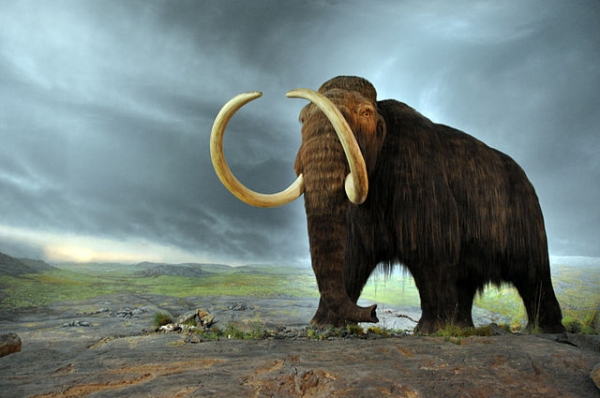Prehistoric Britain
The prehistoric era in Great Britain is divided into roughly the following time periods. 'Prehistoric' means, literally, before recorded history, so that virtually everything we know about these periods has to be obtained from archaeology and other non-written sources of information.
Palaeolithic (c450,000-10,000 BC)
Mesolithic (c10,000-4500 BC)
Neolithic (c4500-2300 BC)
Bronze Age (c2300-700 BC)
Iron Age (c700 BC-43 AD)
The terms 'Bronze Age', 'Iron Age' and so on are used by archaeologists as a convenient shorthand for discussing the chronology of the past. In reality, the changes from one period to the next would have been far less clear cut and more gradual than these sharp distinctions imply.
The accepted dates for these periods also vary in different parts of the world, because different areas developed at different times. Middle Eastern and Mediterranean civilisations, for example, developed metalworking before people living in Britain, so that their Bronze and Iron Ages arrived earlier.
The Palaeolithic
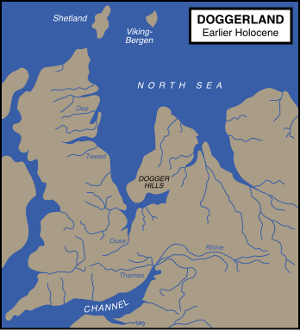
Palaeolithic (Old Stone Age) Britain is the period of the earliest known occupation of Britain by man. This huge length of time saw many changes in the environment, encompassing several glacial and interglacial periods that greatly affected human settlement in the region. Providing dating for this distant period of time is difficult and contentious. The inhabitants of the region at this time were bands of hunter-gatherers who roamed northern Europe following herds of animals, or who supported themselves by fishing. DNA analysis has shown that modern man arrived in Britain before the last ice age but retreated to Southern Europe when much of Britain was ice covered, with the remainder being tundra. At this time the sea level was about 127 m (417 ft.) lower than it is today, so Britain was joined to Ireland and by the area known as Doggerland to the continent of Europe. After the end of the last Ice Age (around 9500 BC), Ireland became separated from Britain; later (around 6500 BC), Britain was cut off from the rest of Europe.
Lower Palaeolithic (up to 250,000 years ago)
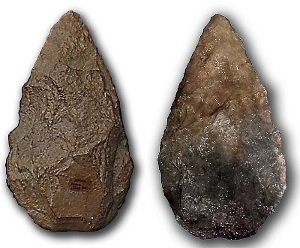
There is evidence from bones and flint tools found in coastal deposits near Happisburgh in Norfolk and Pakefield in Suffolk that a species of Homo was present in what is now Britain around 700,000 years ago. At this time, southern and eastern Britain were linked to continental Europe by a wide land bridge allowing humans to move freely. The current position of the English Channel was a large river flowing westwards and fed by tributaries that would later become the Thames and Seine. Reconstructing this ancient environment has provided clues to the route first visitors took to arrive at what was then a peninsula of the Eurasian continent. Archaeologists have found a string of early sites located close to the route of a now lost watercourse named the Bytham River which indicate that it was exploited as the earliest route west into Britain.
Middle Palaeolithic (from around 180,000 to 40,000 years ago)
From 180,000 to 60,000 there is no evidence of human occupation in Britain. From 60,000 to 40,000 Britain was grass land with giant deer and horse, with woolly mammoths, rhino and carnivores. Neanderthal man had arrived in Britain by around 40,000 years ago.
Upper Palaeolithic (around 40,000 – 10,000 years ago)
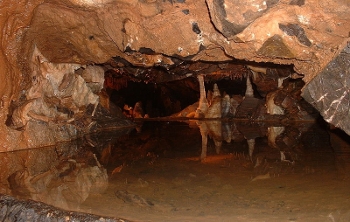
Evidence of Neanderthal occupation of Britain is limited and by 30,000 BC the first signs of modern human (Homo sapiens) activity are known. The most famous example from this period is the burial of the "Red Lady of Paviland" (actually now known to be a man) in modern day coastal south Wales. A final ice age covered Britain between around 70,000 and 10,000 years ago with an extreme cold snap between 22,000 and 13,000 years ago. This may well have driven humans south and out of Britain altogether, pushing them back across the land bridge that had resurfaced at the beginning of the glaciation, possibly to a refuge in Southern France and Iberia. Sites such as Gough's Cave in Somerset dated at 12,000 BC provide evidence suggesting that humans returned to Britain towards the end of this ice age, in a warm period although further extremes of cold right before the final thaw may have caused them to leave again and then return repeatedly. The environment during this ice age period would have been a largely treeless tundra, eventually replaced by a gradually warmer climate, perhaps reaching 17 degrees Celsius (62.6 Fahrenheit) in summer which encouraged the expansion of birch trees as well as shrub and grasses.
The first distinct culture of the Upper Palaeolithic in Britain produced more refined flint tools but also made use of bone, antler, shell, amber, animal teeth, and mammoth ivory. These were fashioned into tools but also jewellery and rods of uncertain purpose. Flint seems to have been brought into areas with limited local resources; the stone tools found in the caves of Devon, such as Kent's Cavern, seem to have been sourced from Salisbury Plain, 100 miles (161 km) east. This is interpreted as meaning that the early inhabitants of Britain were highly mobile, roaming over wide distances and carrying 'toolkits' of flint blades with them rather than heavy, unworked flint nodules or improvising tools extemporaneously. The possibility that groups also travelled to meet and exchange goods or sent out dedicated expeditions to source flint has also been suggested.
The dominant food species were equines (Equus ferus) and Red Deer (Cervus elaphus) although other mammals ranging from hares to mammoth were also hunted, including rhino and hyena. From the limited evidence available, burial seemed to involve skinning and dismembering a corpse with the bones placed in caves. This suggests a practice of excarnation and secondary burial, and possibly some form of ritual cannibalism. Artistic expression seems to have been mostly limited to engraved bone although the cave art at Creswell Crags and Mendip caves are notable exceptions.
Mesolithic (around 10,000 to 5,500 years ago)
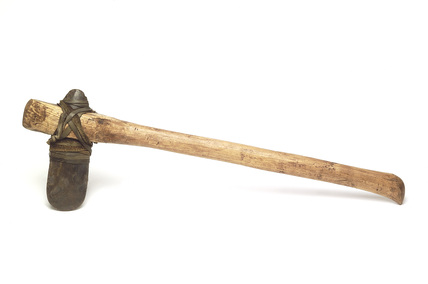
Around 10,000 years ago the ice age finally ended and temperatures rose, probably to levels similar to those today, and forests expanded further. By 9,500 years ago, the rising sea levels caused by the melting glaciers cut Britain off from Ireland and by around 6500 to 6000 BC continental Europe was cut off for the last time. The warmer climate changed the Arctic environment to one of pine, birch and alder forest; this less open landscape was less conducive to the large herds of reindeer and wild horse that had previously sustained humans. Those animals were replaced in people's diets by pig and less social animals such as elk, red deer, roe deer, wild boar and aurochs (wild cattle) which would have required different hunting techniques. Tools changed to incorporate barbs which could snag the flesh of an animal, making it harder for it to escape alive. Woodworking tools such as adzes appear in the archaeological record, although some flint blade types remained similar to their Palaeolithic predecessors. The dog was domesticated because of its benefits during hunting and the wetland environments created by the warmer weather would have been a rich source of fish and game. It is likely that these environmental changes were accompanied by social changes. Humans spread and reached the far north of Scotland during this period. Sites from the British Mesolithic include the Mendips, Star Carr in Yorkshire and Oronsay in the Inner Hebrides. Excavations at Howick in Northumberland uncovered evidence of a large circular building dating to c. 7600 BC which is interpreted as a dwelling. A further example has also been identified at Deepcar in Sheffield, and a building dating to c. 8500 BC was discovered at the Star Carr site. The older view of Mesolithic Britons as nomadic is now being replaced with a more complex picture of seasonal occupation or in some cases, permanent occupation. Travel distances seem to have become shorter, typically with movement between high and low ground.
The Mesolithic-Neolithic transition (around 5,500 – 4000 BC)
Though the Mesolithic environment was of a bounteous nature, the rising population and ancient Britons' success in exploiting it eventually led to local exhaustion of many natural resources. The remains of a Mesolithic elk found caught in a bog at Poulton-le-Fylde in Lancashire had been wounded by hunters and escaped on three occasions, indicating hunting during the Mesolithic. A few Neolithic monuments overlie Mesolithic sites but little continuity can be demonstrated. Farming of crops and domestic animals was adopted in Britain around 4500 BC at least partly because of the need for reliable food sources. Hunter-gathering ways of life would have persisted into the Neolithic at first but the increasing sophistication of material culture with the concomitant control of local resources by individual groups would have caused it to be replaced by distinct territories occupied by different tribes. Other elements of the Neolithic such as pottery, leaf-shaped arrowheads and polished stone axes would have been adopted earlier. The climate had been warming since the later Mesolithic and continued to improve, replacing the earlier pine forests with woodland.
The Neolithic (around 4000 – 2000 BC)
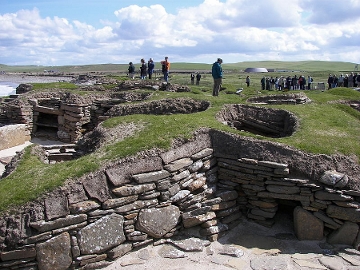
The Neolithic was the period of domestication of plants and animals. Pollen analysis shows that woodland was decreasing and grassland increasing, with a major decline of elms. The winters were typically 3 degrees colder than at present but the summers some 2.5 degrees warmer. The arrival of farming and a sedentary lifestyle as shorthand for the Neolithic is increasingly giving way to a more complex view of the changes and continuities in practices that can be observed from the Mesolithic period onwards. For example the development of Neolithic monumental architecture apparently venerating the dead may represent more comprehensive social and ideological changes involving new interpretations of time, ancestry, community and identity.
In any case, the Neolithic Revolution, as it is called, introduced a more settled way of life and ultimately led to societies becoming divided into differing groups of farmers, artisans and leaders. Forest clearances were undertaken to provide room for cereal cultivation and animal herds. Native cattle and pigs were reared whilst sheep and goats were later introduced from the continent as were the wheats and barleys grown in Britain. However, only a few actual settlement sites are known in Britain, unlike the continent. Cave occupation was common at this time.

The construction of the earliest earthwork sites in Britain began during the early Neolithic (c. 4400 BC – 3300 BC) in the form of long barrows used for communal burial and the first causewayed enclosures, sites which have parallels on the continent. The former may be derived from the long house although no long house villages have been found in Britain, only individual examples. The stone-built houses on Orkney such as those at Skara Brae are however indicators of some nucleated settlement in Britain. Evidence of growing mastery over the environment is embodied in the Sweet Track, a wooden trackway built to cross the marshes of the Somerset Levels and dated to 3807 BC. Leaf-shaped arrowheads, round-based pottery types and the beginnings of polished axe production are common indicators of the period. Evidence of the use of cow's milk comes from analysis of pottery contents found beside the Sweet Track.
The Middle Neolithic (c. 3300 BC – c. 2900 BC) saw the development of cursus monuments close to earlier barrows and the growth and abandonment of causewayed enclosures as well as the building of impressive chamber tombs such as the Maeshowe types. The earliest stone circles and individual burials also appear.
Different pottery types such as Grooved ware appear during the later Neolithic (c. 2900 BC – c.2200 BC) whilst new enclosures, called henges were built, along with stone rows and the famous sites of Stonehenge, Avebury and Silbury Hill reached their peak. Industrial flint mining such as that at Cissbury and Grimes Graves began, with evidence of long distance trade. Wooden tools and bowls were common, and bows were constructed.
The Bronze Age (around 2200 to 750 BC)
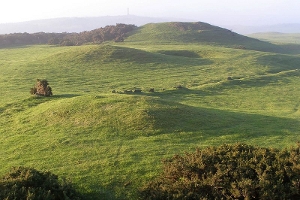
Believed to be of Iberian origin, Beaker techniques brought to Britain the skill of refining metal. At first the users made items from copper, but from around 2,150 BC smiths had discovered how to make bronze (which was much harder than copper) by mixing copper with a small amount of tin. With this discovery, the Bronze Age arrived in Britain. Over the next thousand years, bronze gradually replaced stone as the main material for tool and weapon making.
Britain had large, easily accessible reserves of tin in the modern areas of Cornwall and Devon in what is now southwest England, and thus tin mining began. By around 1,600 BC the southwest of Britain was experiencing a trade boom as British tin was exported across Europe, evidence of ports being found in southern Devon at Bantham and Mount Batten. Copper was mined at the Great Orme in North Wales.
The Beaker people were also skilled at making ornaments from gold, and examples of these have been found in graves of the wealthy Wessex culture of central southern Britain.
Early Bronze Age Britons buried their dead beneath earth mounds known as barrows, often with a beaker alongside the body. Later in the period, cremation was adopted as a burial practice with cemeteries of urns containing cremated individuals appearing in the archaeological record, with deposition of metal objects such as daggers. People of this period were also largely responsible for building many famous prehistoric sites such as the later phases of Stonehenge along with Seahenge. The Bronze Age people lived in round houses and divided up the landscape. Stone rows are to be seen on, for example, Dartmoor. They ate cattle, sheep, pigs and deer as well as shellfish and birds. They carried out salt manufacture. The wetlands were a source of wildfowl and reeds. There was ritual deposition of offerings in the wetlands and in holes in the ground.
The Iron Age (around 750 BC – 43 AD)
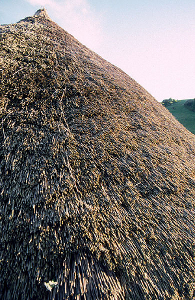
In around 750 BC iron working techniques reached Britain from southern Europe. Iron was stronger and more plentiful than bronze, and its introduction marks the beginning of the Iron Age. Iron working revolutionised many aspects of life, most importantly agriculture. Iron tipped ploughs could churn up land far more quickly and deeply than older wooden or bronze ones, and iron axes could clear forest land far more efficiently for agriculture. There was a landscape of arable, pasture and managed woodland. There were many enclosed settlements and land ownership was important.
Iron Age Britons lived in organised tribal groups, ruled by a chieftain. As people became more numerous, wars broke out between opposing tribes. This was traditionally interpreted as the reason for the building of hill forts, although the siting of some earthworks on the sides of hills undermined their defensive value, hence "hill forts" may represent increasing communal areas or even 'Elite Areas'. However some hillside constructions may simply have been cow enclosures. Although the first had been built about 1,500 BC, hillfort building peaked during the later Iron Age. There are over 2000 Iron Age hillforts known in Britain. By about 350 BC many hillforts fell out of use and the remaining ones were reinforced. Pytheas was quoted as writing that the Britons were renowned wheat farmers. Large farmsteads produced food in industrial quantities and Roman sources note that Britain exported hunting dogs, animal skins and slaves.
The Late pre-Roman Iron Age
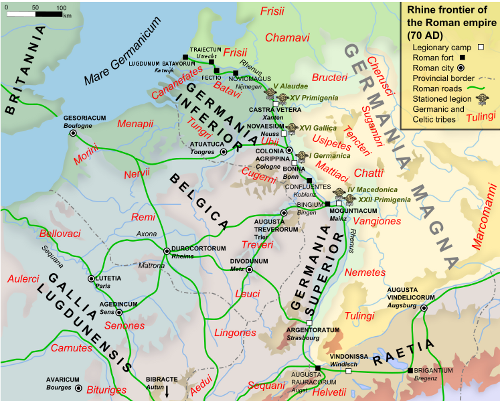
The last centuries before the Roman invasion saw an influx of mixed Germanic-Celtic speaking refugees from Gaul (approximately modern day France and Belgium) known as the Belgae, who were displaced as the Roman Empire expanded around 50 BC. They settled along most of the coastline of Southern Britain between about 200 BC and AD 43. A Gaulish tribe known as the Parisii, who had cultural links to the continent, appeared in north-east England.
From around 175 BC, the areas of Kent, Hertfordshire and Essex developed especially advanced pottery-making skills. The tribes of south-east England became partially Romanised and were responsible for creating the first settlements (oppida) large enough to be called towns.
The last centuries before the Roman invasion saw increasing sophistication in British life. About 100 BC, iron bars began to be used as currency, while internal trade and trade with continental Europe flourished, largely due to Britain's extensive mineral reserves. Coinage was developed, based on continental types but bearing the names of local chieftains. This was used in south-east England, but not in areas such as Dumnonia in the west.
As the Roman Empire expanded northwards, Rome began to take interest in Britain. This may have been caused by an influx of refugees from Roman occupied Europe, or Britain's large mineral reserves.
In next month's advanced level graded reader will investigate the influence of the Romans on Great Britain.
Prehistoric Britain - Comprehension Questions
1. What problems are we faced with when trying to understand the Prehistoric Period?
2. How is modern technology helping archaeologists piece together the past?
3. What facilitated entry to Britain but also at the same time made life more challenging?
4. How did social structures change through the Prehistoric era? What allowed these social changes?
5. How did the Beaker culture get its name?
6. What were the reasons for the outbreaks of tribal warfare during the Iron age?


